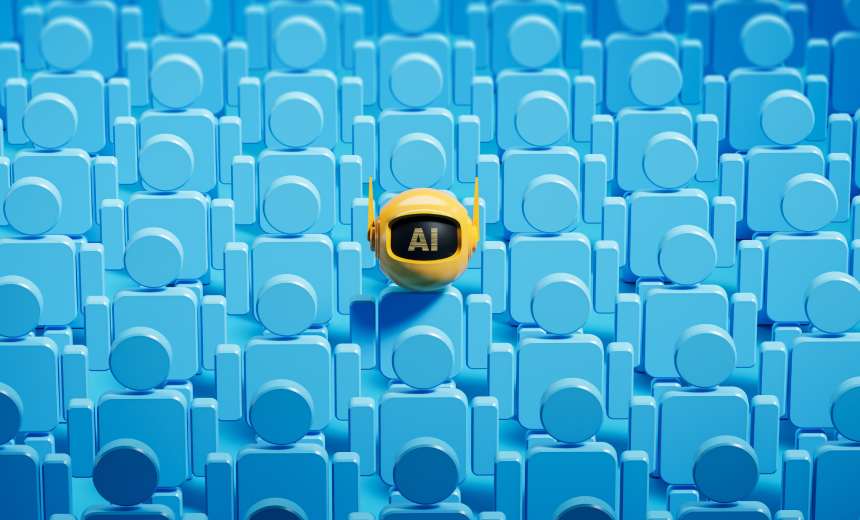You may need seen viral movies of Wendy’s drive-thru clients within the United States ordering their quick meals from the agency’s generative AI bot Wendy’s FreshAI. Most present a really human-like transaction punctuated with cries of amazement at how briskly, correct and well mannered the system is.
While the system and others prefer it are of their infancy, and some nonetheless rely closely on human help, retailers are investing enormous sums in AI to exchange human staff.
Why the frenzy to automate? It would possibly seem to be it’s all about slashing the wage invoice, and straight AI-for-human swaps are certainly taking place in lots of roles.
But there’s one other power driving the tsunami of restructuring in retail. At stake is the hidden lifeblood of the Twenty first-century enterprise: knowledge.
Superhuman knowledge harvesters
Retail workers don’t sometimes feed a lot knowledge again right into a enterprise. Instead knowledge circulation shapes them personally, and they develop what we recognise as expertise or experience. This is without doubt one of the causes companies historically attempt to retain workers for lengthy intervals.
Retail AI bots, then again, fully automate knowledge assortment. The bot is a part of a enterprise’s broader laptop system, so the main points of each buyer interplay will be piped straight to a database. The knowledge harvest can embrace the whole “stimulus” introduced to every buyer: the preliminary greeting, the amount, the tone, the pacing, responses to buyer questions, and in fact the greenback and cents consequence.
Depending on a agency’s moral place, an AI bot can be designed to reap not solely the shopper’s phrases but additionally varied “meta-facts”: male or feminine, younger or outdated, skinny or overweight, quick or tall, tattoos or no tattoos.
In truth, with video and audio recording so commonplace, there isn’t any reason every thing about an interplay can’t be captured for later breakdown and evaluation by AI.
By substituting bots for people, all the info that when ended up in workers (who, possessing the info as experience, would possibly demand extra money to remain) can now go straight into the digital vaults of the enterprise.
What makes the enterprise case for AI bots much more compelling, nonetheless, is that they will full the loop and use the info in addition to harvest it.
Dynamic “touchpoint” creators
Retailers pay numerous consideration to “touchpoints” – crucial moments of contact the place they will affect the shopper’s perceptions and choices.
In the previous, human workers have been chosen or educated to supply efficient touchpoints. For instance, youngsters in vibrant uniforms staffing a quick meals restaurant lend a sure picture and vibe. And the scripts and prompts they ship, similar to “Do you need fries with that?”, come straight from a guide.
But human workers aren’t actually in a position to mannequin tens of millions of previous buyer interactions, or weigh them towards the shopper standing in entrance of them.
Retail bots can. They can full real-time “knowledge loops”.
What does that imply? Using gigabyes of previous knowledge, retail bots can profile the present buyer and modify their behaviour accordingly, work together with the shopper, and then feed again the info created for higher efficiency subsequent time. And that subsequent time may be two seconds later at an similar outlet on the opposite aspect of the nation with an analogous buyer.
Businesses are striving to grow to be equations – that AI can resolve
All these knowledge loops are being closed at the price of human jobs as a result of full digitisation is at the moment’s enterprise very best.
Why? Because a enterprise that runs on knowledge flowing in clean loops is actually an equation. And if a enterprise is an equation, you need to use (you guessed it) the newest AI to continuously tweak your retail bots and pull different levers to maximise the underside line.
The solutions AI supplies to the important query “How will we make more cash?” will be extraordinarily granular. For instance, based mostly on knowledge from retail bots, AI would possibly in the future counsel (and take a look at and implement) a further 300 millisecond pause earlier than asking chubby clients with brown eyes, “Anything else?”. And it would improve income for causes no person understands.
This leaves clients in a bizarre place.
Data loops create a enterprise so agile that clients really feel like their minds are not simply being learn however anticipated. Think that’s far-fetched? You are in all probability already acquainted with how properly this works from lengthy hours glued to algorithmic pioneers and full-equation companies like Google, YouTube, Amazon, Facebook and TikTok.
Retailers wish to use AI to get in on the motion.
In truth, on the heels of its AI drive-thru knowledge bonanza, Wendy’s lately needed to dampen experiences it was contemplating Uber-style “dynamic pricing”.
So which retail jobs will AI take first?
There’s no easy reply to this difficult query. But I can provide a guideline.
AI thrives on knowledge. If your job includes numerous knowledge, and the info is at the moment not captured (folks dealing with high-volume site visitors, like drive-thru staff), or it doesn’t inform the best way you ship your service (drive-thru staff once more, but additionally these dealing with advanced merchandise) – be careful. You are blocking an information loop, and chances are you’ll be within the crosshairs.
If, then again, you’re not a sinkhole for an excessive amount of knowledge, and numerous knowledge wouldn’t make an enormous distinction to you as a touchpoint, you’re in all probability secure for some time. You can chill out and simply wait to grow to be a sufferer of the common wage-saving kind of AI restructuring.
https://theconversation.com/can-i-take-your-order-and-your-data-the-hidden-reason-retailers-are-replacing-staff-with-ai-bots-229202



